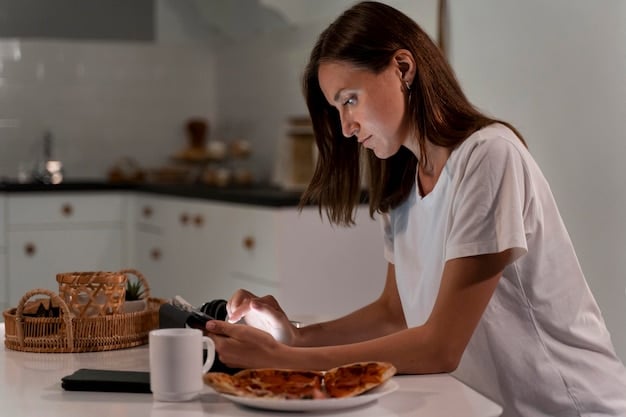Beat Jet Lag: US Travelers’ Guide for 2025 Cross-Time Zone Journeys

Beat Jet Lag: Proven Strategies for US Travelers Crossing Time Zones in 2025 involves adjusting pre-flight habits, optimizing in-flight comfort, and employing post-arrival techniques to minimize disruptions to your sleep schedule and overall well-being.
Planning a cross-time zone trip in 2025? Don’t let jet lag ruin your experience. Discover how to beat jet lag: proven strategies for US travelers crossing time zones in 2025 to arrive refreshed and ready to explore.
Understanding Jet Lag: Why It Happens
Jet lag, also known as desynchronosis, is more than just feeling a bit tired after a flight. It’s a physiological condition that results from disruptions in your body’s natural circadian rhythms. These rhythms are finely tuned to regulate sleep-wake cycles, hormone release, and other essential bodily functions.
When you rapidly travel across multiple time zones, your internal clock becomes misaligned with the new local time. This misalignment can manifest as various symptoms, impacting your overall well-being and travel experience.
The Science Behind Circadian Rhythms
The suprachiasmatic nucleus (SCN), located in the hypothalamus of the brain, is the master regulator of circadian rhythms. It receives information about light exposure from the eyes and uses this information to synchronize the body’s internal processes with the external environment.
When you travel quickly through time zones, the SCN struggles to adjust immediately, leading to a mismatch between your internal clock and the new environment. This mismatch disrupts the normal release of hormones like melatonin and cortisol, which play crucial roles in sleep and alertness.
- Melatonin: This hormone promotes sleepiness. Its production is typically highest in the evening and lowest in the morning. When traveling across time zones, the timing of melatonin release can be out of sync with the new sleep-wake cycle.
- Cortisol: Often called the “stress hormone,” cortisol helps regulate alertness and energy levels. Its levels are usually highest in the morning, providing a natural boost to wakefulness. Jet lag can disrupt the normal cortisol rhythm, leading to fatigue and difficulty concentrating.
- Other Factors: Dehydration, cabin pressure, and disrupted meal times can also contribute to jet lag symptoms, exacerbating the effects of circadian rhythm disruption.
Understanding the underlying science behind jet lag can empower you to take proactive steps to mitigate its effects. By strategically adjusting your pre-flight habits, in-flight behavior, and post-arrival routine, you can help your body adapt more quickly to the new time zone and minimize the discomfort associated with jet lag.
Pre-Flight Strategies for Minimizing Jet Lag
The journey to beat jet lag: proven strategies for US travelers crossing time zones in 2025 actually begins before you even step onto the plane. By implementing a few key pre-flight strategies, you can significantly reduce the severity of jet lag symptoms.
These strategies primarily focus on gradually shifting your sleep schedule and optimizing your body’s preparation for the journey ahead.
Adjusting Your Sleep Schedule
Gradually adjusting your sleep schedule in the days leading up to your flight can help your body adapt more smoothly to the new time zone. This is particularly important when traveling eastward, where advancing your sleep schedule is often recommended.
Consider these tips for adjusting your sleep schedule:
Start shifting your bedtime and wake-up time by 30-60 minutes each day, beginning several days before your departure. If you’re traveling east, try going to bed and waking up earlier. If you’re traveling west, shift your schedule later.
Use light exposure strategically. In the morning, expose yourself to bright light (sunlight or a light therapy lamp) to help advance your circadian rhythm. In the evening, minimize exposure to blue light from electronic devices.
- Eastward Travel: Shift your bedtime earlier by 1-2 hours each night for a few days before your flight.
- Westward Travel: Shift your bedtime later by 1-2 hours each night for a few days before your flight.
- Napping: Avoid long naps in the days leading up to your flight, as they can disrupt your sleep schedule.
By making gradual adjustments to your sleep schedule, you can ease the transition to the new time zone and minimize the shock to your circadian rhythm. This proactive approach can make a significant difference in your overall experience of jet lag.

Optimizing Your In-Flight Experience
The time spent in the air provides a valuable opportunity to further mitigate the effects of jet lag. By making mindful choices and adopting certain strategies during your flight, you can enhance your comfort and promote adaptation to the new time zone.
These strategies focus on hydration, nutrition, light exposure, and sleep management.
Hydration and Nutrition
Staying hydrated and making smart food choices during your flight is crucial for minimizing jet lag symptoms. Dehydration and unhealthy eating patterns can exacerbate fatigue and disrupt your sleep-wake cycle.
- Drink Plenty of Water: Airplane cabins have low humidity levels, which can lead to dehydration. Aim to drink plenty of water throughout your flight, avoiding sugary drinks and excessive caffeine, which can further dehydrate you.
- Avoid Alcohol: While alcohol may seem like a good way to relax on a flight, it can disrupt your sleep and worsen dehydration. It’s best to avoid alcohol or consume it in moderation.
- Eat Light, Healthy Meals: Choose light, healthy meals that are easy to digest. Avoid heavy, greasy foods that can make you feel sluggish and uncomfortable. Opt for fruits, vegetables, lean protein, and whole grains.
Managing Light Exposure and Sleep
Controlling your light exposure and sleep patterns during the flight can help your body adjust to the new time zone. This involves using eye masks, earplugs, and adjusting your watch to the destination time.
If it’s daytime at your destination, try to stay awake during the flight. If it’s nighttime, try to sleep. Use an eye mask and earplugs to block out light and noise, and consider using a sleep aid if necessary (consult with your doctor before taking any medication).
Adjust your watch to the destination time as soon as you board the plane. This mental cue can help you start thinking in terms of the new time zone.
By prioritizing hydration, nutrition, light exposure, and sleep management during your flight, you can create a more comfortable and conducive environment for adapting to the new time zone. These strategies can help you arrive at your destination feeling refreshed and ready to explore.
Post-Arrival Strategies for Accelerating Adaptation
Once you’ve arrived at your destination, it’s essential to continue implementing strategies to beat jet lag: proven strategies for US travelers crossing time zones in 2025. This involves immediately adapting to the local schedule, seeking natural light, and engaging in physical activity.
These strategies focus on reinforcing the new circadian rhythm and minimizing the temptation to revert to your old sleep-wake cycle.
Adapting to the Local Schedule
One of the most effective ways to overcome jet lag is to immediately adapt to the local schedule. This means eating meals at the appropriate times, going to bed and waking up at local times, and avoiding naps during the day.
Resist the urge to nap, even if you feel tired. Napping can disrupt your sleep cycle and make it harder to adjust to the new time zone. If you must nap, limit it to 20-30 minutes and avoid napping late in the day.
Consider the following tips for adjusting to the new schedule:
Eat meals at local times, even if you’re not hungry. This will help regulate your body’s internal clock.
Plan activities that align with the local time. If it’s daytime, engage in outdoor activities. If it’s nighttime, wind down and prepare for bed.
- Meal Timing: Eat your meals according to the local schedule, even if you don’t feel hungry.
- Sleep Schedule: Go to bed and wake up at the local times, even if you feel tired or restless.
- Avoid Naps: Resist the urge to nap, as naps can disrupt your sleep cycle.
By immediately adapting to the local schedule, you can reinforce the new circadian rhythm and minimize the disruption caused by jet lag. This proactive approach can help you feel more energized and alert throughout your trip.
Seeking Natural Light and Physical Activity
Exposure to natural light and physical activity can significantly accelerate your adaptation to the new time zone. These factors help regulate your circadian rhythm and boost your energy levels.
Spend time outdoors during the day, especially in the morning. Natural light helps reset your body’s internal clock and promotes wakefulness.
Engage in moderate physical activity, such as walking, jogging, or swimming. Exercise can boost your energy levels and improve your sleep quality. Avoid strenuous exercise close to bedtime.
Consider these tips for maximizing benefits:
Take a walk in the park or explore the city on foot.
Go for a swim or bike ride.
Avoid strenuous exercise close to bedtime, as it can interfere with sleep.

The Role of Technology and Apps in Jet Lag Management
In 2025, technology offers a range of tools and apps to help manage jet lag. These resources provide personalized advice, track your sleep patterns, and offer guidance on light exposure and melatonin supplementation.
Explore the various apps and gadgets available to find the best fit for your individual needs and preferences.
Jet Lag Apps
Several apps are designed specifically to help travelers combat jet lag. These apps use algorithms to analyze your travel itinerary and provide personalized recommendations for adjusting your sleep schedule, managing light exposure, and timing melatonin supplementation.
Popular jet lag apps include Timeshifter, Entrain, and Jet Lag Rooster. These apps take into account your travel direction, the number of time zones crossed, and your individual sleep patterns to generate a customized plan for minimizing jet lag.
Timeshifter, for example, is used by astronauts and athletes to optimize their performance across time zones. It provides precise recommendations for when to seek light and darkness, when to take melatonin, and when to adjust your sleep schedule.
Entrain uses a simpler approach, providing guidance on light exposure to help reset your circadian rhythm. It offers a color-coded schedule that tells you when to seek bright light, dim light, or darkness.
Wearable Technology
Wearable technology, such as smartwatches and fitness trackers, can also play a role in managing jet lag. These devices can track your sleep patterns, monitor your activity levels, and provide insights into your overall health.
By tracking your sleep patterns, you can identify how jet lag is affecting your sleep quality and make adjustments to your routine accordingly. You can also use wearable technology to monitor your activity levels and ensure that you’re getting enough exercise to boost your energy levels and improve your sleep.
Some wearable devices also offer features designed specifically to help combat jet lag. For example, some smartwatches have built-in light sensors that can track your light exposure and provide recommendations for adjusting your schedule.
By leveraging technology and apps, you can gain a better understanding of your individual needs and implement a personalized plan for minimizing jet lag. These resources can help you arrive at your destination feeling refreshed, energized, and ready to explore.
Future Trends in Jet Lag Research and Treatment
Research into jet lag is ongoing, and new strategies and treatments are continually being developed. In the coming years, we can expect to see even more innovative approaches to managing this common travel ailment.
These trends include personalized interventions, advanced light therapy, and the use of chronobiotics.
Personalized Interventions
As our understanding of circadian rhythms and individual differences grows, we can expect to see more personalized interventions for jet lag. These interventions will take into account factors such as your chronotype (your natural sleep-wake preference), your age, your health status, and your travel itinerary to generate a customized plan for minimizing jet lag.
For example, someone who is a “morning person” may benefit from a different approach to adjusting their sleep schedule than someone who is a “night owl.” Similarly, someone with a pre-existing sleep disorder may require a more comprehensive strategy for managing jet lag.
Personalized interventions may also involve the use of genetic testing to identify individual variations in circadian rhythm genes. This information can be used to tailor light therapy, melatonin supplementation, and other interventions to your specific needs.
Advanced Light Therapy
Light therapy is a well-established treatment for jet lag, but ongoing research is exploring new ways to optimize its effectiveness. This includes the development of more targeted light therapy devices that can deliver specific wavelengths of light at precise times to reset your circadian rhythm.
For example, some light therapy devices use blue light, which is particularly effective at suppressing melatonin production and promoting wakefulness. Other devices use red light, which is thought to have a more calming effect and may be beneficial for promoting sleep.
Advanced light therapy may also involve the use of virtual reality (VR) headsets to simulate natural light exposure. This could be particularly useful for travelers who are confined to indoor spaces, such as airplane cabins or hotel rooms.
| Key Point | Brief Description |
|---|---|
| ☀️ Pre-Flight Adjustment | Gradually shift your sleep schedule before your flight. |
| 💧 In-Flight Hydration | Drink plenty of water and avoid alcohol during the flight. |
| ⏰ Post-Arrival Adaptation | Adjust immediately to the local schedule and seek natural light. |
| 📱 Technology Use | Utilize apps and wearables to manage light exposure and sleep. |
FAQ
▼
Jet lag is a temporary sleep disorder caused by rapidly crossing multiple time zones, disrupting your body’s natural sleep-wake cycle. This can lead to fatigue, insomnia, and other symptoms.
▼
The duration of jet lag varies depending on the number of time zones crossed and individual factors. It generally takes about one day per time zone crossed to fully recover.
▼
Melatonin supplements can help regulate your sleep-wake cycle and reduce jet lag symptoms. Consult with your doctor before taking any medication, including supplements.
▼
Many people find it easier to adjust when traveling west, as you are effectively lengthening your day. Traveling east requires advancing your sleep schedule, which can be more challenging.
▼
Yes, children can experience jet lag. Adjust their schedules gradually before the trip, keep them hydrated during the flight, and encourage outdoor activities after arrival to help them adapt.
Conclusion
Beat jet lag: proven strategies for US travelers crossing time zones in 2025 doesn’t have to be a daunting task. By implementing these proactive strategies before, during, and after your flight, you can minimize the disruptive effects of jet lag and arrive at your destination feeling refreshed and ready to enjoy your travels.





